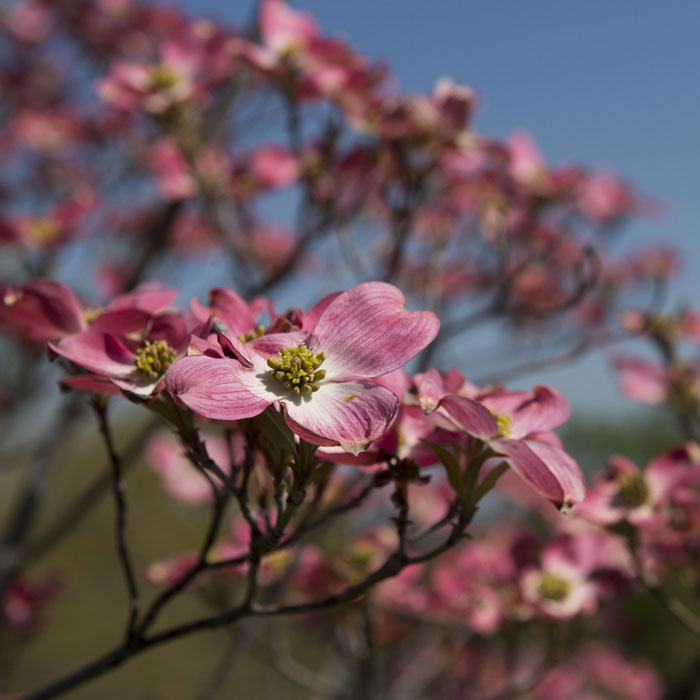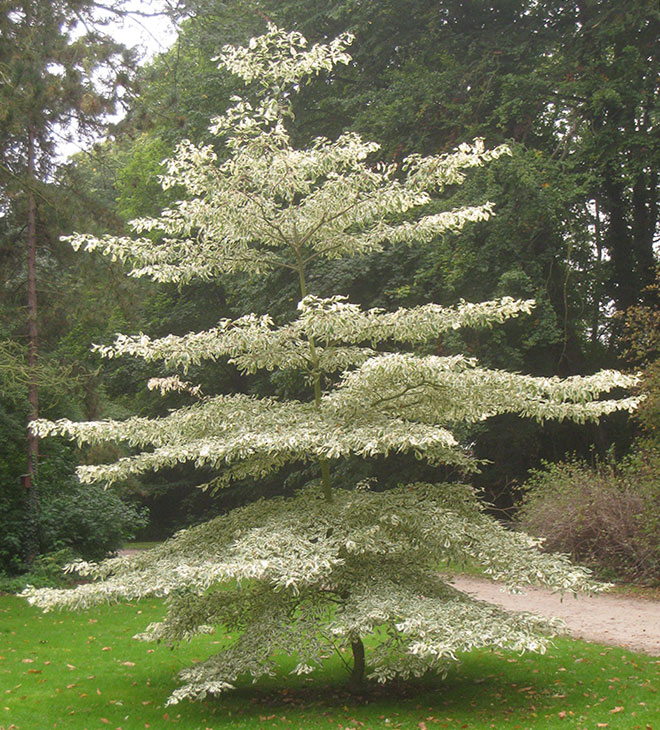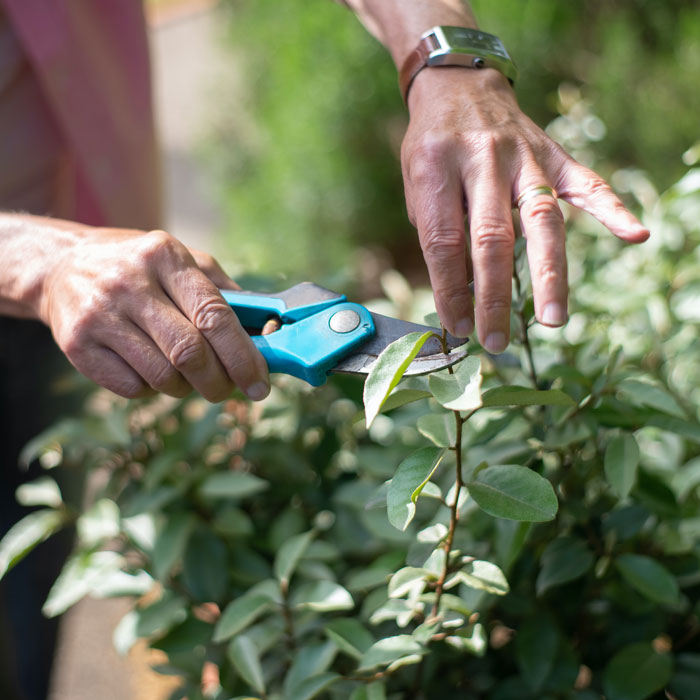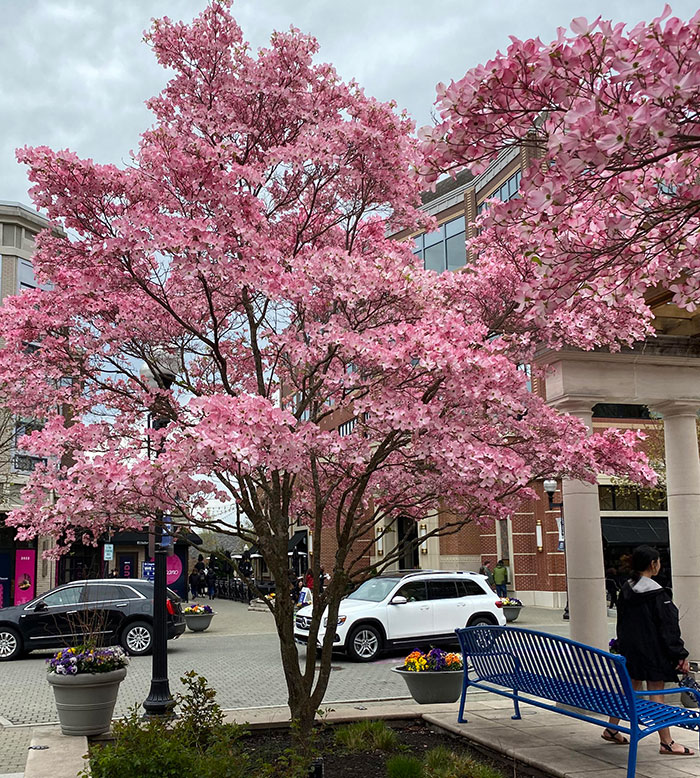The elegant dogwood tree peppers North American and European landscapes. These striking beauties produce flowers of various colors — from pristine white to blushing pink and vibrant red. Even the dogwood tree leaves are glossy and turn scarlet in the fall.
These ornamental trees are a favorite year-round in gardens and public spaces, but they look even more stunning in the spring! Still, dogwoods have an all-year appeal — they produce stunning flowers in spring, bright red berries in summer, scarlet foliage in fall, and tiny, dormant buds in winter.
Image credit: thetreecenter
Beyond their aesthetic value, dogwood trees play a vital role in the ecosystems they inhabit. Their distinct red berries are a vital food source for migratory birds. Their presence can significantly enhance the biodiversity of a region.
There are over 15 varieties of flowering dogwood trees, each with unique characteristics and flowers. While some species are found in the wilderness, there are also large, ornamental varieties that are ideal for landscaping. Their diversity ensures that there is a dogwood tree suited to different climates.
In this guide, we’ll tell you how to plant and care for these remarkable trees so they continue to thrive throughout the year in your yard.
Image credit: dreamywhiteslifestyle
- What is a Dogwood Tree?
- Interesting Facts About Dogwoods
- 10 Common Varieties of Dogwood Trees
- Flowering Dogwood Tree (Cornus florida)
- Kousa Dogwood (Cornus kousa)
- Bunchberry (Cornus canadensis)
- Cornelian Cherry (Cornus mas)
- Red Osier Dogwood (Cornus sericea)
- Pagoda Dogwood (Cornus alternifolia)
- Pacific Dogwood (Cornus nuttallii)
- Bloodtwig Dogwood (Cornus sanguinea)
- Gray Dogwood (Cornus racemosa)
- Giant Dogwood (Cornus controversa)
- How to Plant a Dogwood Tree
- Dogwood Tree Care and Maintenance
- FAQs About Dogwood Trees
What is a Dogwood Tree?
Dogwood is a deciduous tree renowned for its showy blossoms in various hues, such as white, pink, red, and sometimes yellow. They typically bloom in spring and can make any landscape look lush and vibrant.
Quick Facts
Scientific Name: Cornus Florida (flowering dogwood trees)
Native habitat: North America, Europe, China, Japan
Hardiness: Winter hardy to USDA Zone 5 to 9.
Tree size: 30 to 40 feet.
How to Identify a Dogwood Tree
Identifying a dogwood tree is relatively straightforward as they have a distinct appearance. These are some key characteristics to help you recognize a dogwood tree:
- Leaves: Dogwood tree leaves are shiny and have smooth margins. The leaves are dark green during the growing season and can turn red or yellow in the fall.
- Bark: Young dogwood trees have smooth, grayish-green bark, which becomes rougher and darker as they mature.
- Branches: Branches of some varieties turn bright red during the fall and winter months.
- Flowers: They have showy, four-petaled flowers that blossom in spring. Each flower cluster is surrounded by large bracts (leaves that resemble petals). This gives an appearance of a single, large flower.
- Fruit: Dogwood trees produce small, berry-like cluster fruits in bright red or orange color. Dogwood berries are considered toxic and should not be consumed by humans.
- Size and Shape: Dogwood trees vary in size depending on the species. They can range from small, understory trees to larger, ornamental varieties. Some species have a shrub-like appearance.
Image credit: Arlington National Cemetery
Interesting Facts About Dogwoods
Did you know dogwoods have a fascinating and rich history? Here are some interesting facts about them:
What is Special about Dogwood?
Dogwood trees have been around for a long time. Fossil records suggest they existed over 90 million years ago, making them one of the oldest flowering plants!
The tree gets its name from its smooth, straight twigs. They were used to make butchers’ skewers, which were called ‘dags’ or ‘dogs’ in the olden times, hence the name dogwood.
Another cool fact about the tree is that the states of Virginia, North Carolina, and Missouri recognized the dogwood as the state flower/state tree.
Image credit: starfieldvineyards
What is the Legend of the Dogwood Tree and Jesus?
There’s a Christian folklore that the dogwood tree used to be much taller. According to legend, it was used to crucify Jesus. Because of this, the tree was cursed to become small. It’s typically seen as an understory tree — meaning it’s a shade-tolerant species that grows under the crown of tall trees.
It’s believed that the dogwood blossoms symbolize the cross, with four petals representing the four corners of the world.
It’s also associated with the Easter holiday. The tree blooms early in the spring, often before its leaves appear. This is seen as a symbol of renewal and resurrection and has come to be associated with Easter.
What Does the Dogwood Tree Symbolize?
Dogwood blossoms are often linked to qualities of purity and innocence due to their delicate appearance and white or pink hues. They symbolize love, affection, and beauty.
In the Chinese culture, dogwood is linked with happiness and youthful energy. They believe it brings positive vibes inside the home. Many people also prefer to get dogwood flower tattoos to symbolize transformation.
In some regions, particularly in the Appalachian culture of the United States, dogwood trees are believed to have protective qualities. Planting a dogwood tree near a home is thought to provide protection and bring good luck.
What is the Dogwood Tree Used for?
Dogwood bark produces a relaxing scent and is commonly used in aromatherapy. It is said to relieve stress. Some Native American tribes also use various parts of the tree for medicinal purposes.
They are also useful for erosion control, particularly on hillsides and along riverbanks. They have extensive root systems that help stabilize soil. They are planted in buffer zones, which are areas of vegetation along water bodies. Dogwoods play a vital role in maintaining the integrity of buffer zones by filtering pollutants and preventing sediment runoff.
Image credit: National Parks Gallery
10 Common Varieties of Dogwood Trees
Flowering Dogwood Tree (Cornus florida)
This is the most well-known species of dogwood. Cornus florida is native to the eastern United States, such as Virginia and North Carolina. This flowering dogwood tree has white or pink bracts that bloom in early spring. The picturesque blooms give way to vibrant shades of red leaves in the fall. The pink dogwood tree can be recognized by its stunted growth and flat crown. It grows best in acidic soil in areas with afternoon shade.
Image credit: dixpark
Kousa Dogwood (Cornus kousa)
This tree is native to Asian countries, such as Japan, Korea, and China. This species is quite small in height and also appears as a multi-stemmed shrub. Kousa dogwood blooms in late spring and has distinctive pointed petals that can be either yellowish-green or pristine white. It produces unique, spiky pinkish-red berries and offers excellent fall foliage.
Image credit: Cathi Bodine
Bunchberry (Cornus canadensis)
Bunchberry is a shrub that grows only a few inches. It’s a low-growing ground cover and is common in northern woodlands. This variety is also called the Canadian bunchberry or dwarf cornel. It produces distinct white flowers and red fruits in late summer. This variety grows in Zones 2 to 6 and requires part shade.
Image credit: PacificwestcoastII
Cornelian Cherry (Cornus mas)
This species is native to Europe and western Asia and produces a cherry-like red fruit that is considered safe to consume. The Cornelian variety is a large shrub or small tree that grows up to 20–25 feet. It grows best in Zones 4 to 8 and needs full sun exposure.
Image credit: Rawchaa
Red Osier Dogwood (Cornus sericea)
The red osier, also known as the red twig, produces striking red stems. The stem is green in the spring but starts turning red at the beginning of fall. It turns a bright shade of red in winter, giving a perfect contrast to a snowy landscape.
The red twig is a medium-sized shrub that grows approximately 6 to 9 feet. It produces a beautiful cluster of white dogwood flowers and white berries that are quite attractive to birds.
Image credit: uogarboretum
Pagoda Dogwood (Cornus alternifolia)
This white dogwood tree resembles a pagoda, with a flat crown and branches arranged in layers. It also has a feature that distinguishes it from other dogwoods — an alternate leaf pattern. Its leaves are arranged alternately instead of in opposite positions on the stem.
It’s typically a large shrub but can grow into a small tree with proper pruning. The pagoda dogwood produces white springtime flowers and bluish-black berries.
Image credit: mgnvsocialmedia
Pacific Dogwood (Cornus nuttallii)
This species is also known as the mountain dogwood and is typically found in the regions of British Columbia, California, Idaho, and Oregon. This is another white dogwood tree that produces white bracts and red fruit.
Pacific dogwood is quite hardy and can grow in Zones 7 to 9. It can thrive in dry, drought-like conditions with little sunlight. It appears quite similar to the flowering dogwood tree. However, its white bracts are much larger, and it produces yellow leaves during fall.
Image credit: Elden MILLER
Bloodtwig Dogwood (Cornus sanguinea)
This variety is also known as the common dogwood or European dogwood. It’s typically a shrub or a dwarf red dogwood tree that grows no more than 5 to 15 feet. As the name suggests, it has striking dark red branches. It produces white flowers and bluish-black fruit.
Image credit: Joe Mabel, CC BY-SA 4.0 DEED
Gray Dogwood (Cornus racemosa)
Gray dogwood is a deciduous shrub that can grow 10 to 20 feet. It produces gorgeous white berries in summer.
This is one of the few dogwood species that thrive in the sun. It can grow abundantly in areas with thin canopies. It appears similar to Cornus sericea, however, it can be distinguished by its light gray bark.
Image credit: Frank Mayfield, CC BY-SA 2.0 DEED
Giant Dogwood (Cornus controversa)
This variety is an Asian native. The giant dogwood has a distinctive horizontal branching pattern and layers of creamy white flowers and and bluish-black berries.
The giant dogwood tree can grow up to 30 to 45 feet. Just like Cornus alternifolia, its leaves are also arranged in alternate pattern. It produces purple foliage in fall.
Image credit: Daderot
How to Plant a Dogwood Tree
When planted correctly, the dogwood tree can thrive for 40-60 years. However, you’ll first need to figure out the right variety based on your hardiness zone. Almost all varieties need partial sunlight and afternoon shade to thrive.
The best time to plant a dogwood tree is when the soil has moisture. So, the ideal time to plant is either early spring or the beginning of fall. Make sure to choose the right location in your yard, as it can affect the height of the tree. Typically, trees exposed to full sunlight won’t grow as much as the ones grown in shade. Choose a site that gets dappled sunlight. Dogwoods are typically used to create a border for the yard.
You can start a dogwood tree by using saplings purchased at a nursery. Make sure to untangle young roots and prune damaged or overly long roots. Place the sapling in a hole a foot wider than the roots. Refill the hole with soil, and tap it down gently to eliminate air pockets.
Soil
Flowering dogwood trees prefer slightly acidic to neutral soil with good drainage. Adding organic matter to the soil, such as compost, can enhance both moisture retention and drainage.
Sunlight
Dogwood trees need no more than 4–6 hours of sunlight daily. Long exposure to the sun may cause leaf burn.
Water
Maintain adequate moisture, especially during the tree’s early years. Water deeply and consistently, especially during dry spells. Mulching around the base can help retain soil moisture.
Image credit: Karolina Grabowska
Propagation
Dogwood trees can be propagated from seeds, cuttings, or layering.
To propagate from seeds, gather ripe dogwood fruit in the fall and extract the seeds from the pulp. Store the seeds in a sealed plastic bag with a moist medium like peat moss to break their dormancy. They will need 90 to 120 days to start germination.
Sow the stratified seeds in early spring in containers or a nursery bed until they are ready to be transplanted into their permanent location in the garden.
To propagate from cuttings, select healthy, non-flowering branches that aren’t too woody and have several sets of leaves. Cut 4-6 inches from the selected branches, making sure to cut just below a node. Dip the cut end in a rooting hormone to stimulate root development.
Plant the cuttings in a well-draining medium and cover them with a plastic bag to mimic a greenhouse. This maintains humidity and encourages root growth. It may take several weeks to several months for roots to develop.
To propagate by layering, select a low, flexible branch and make a small wound on the underside. Bury the wounded portion of the branch in a shallow trench filled with moist, well-draining soil. Roots will form at the wounded site over several months.
After roots have developed, carefully cut the branch from the parent tree and transplant it to its desired location.
Image credit: Kampus Production
Dogwood Tree Care and Maintenance
Fertilization
Dogwoods are quite hardy and thrive in the wild. This means they don’t need too much fertilizer. The best time to fertilize your dogwood tree is in early spring, just before new growth begins. This helps provide the necessary nutrients for the upcoming growing season.
Use a diluted, slow-release fertilizer with equal parts of nitrogen, phosphorus, and potassium. A 10-10-10 or 12-12-12 fertilizer is suitable. Make sure to water the area thoroughly after fertilizing the soil. This helps the tree absorb the nutrients and prevents the burning of the roots.
Pruning
Pruning dogwood trees can help maintain their shape, health, and aesthetic appeal. The ideal time for pruning is late fall to early winter when the tree is dormant. Avoid pruning during the growing season, as it can affect flowering and cause stress to the tree.
Start by removing any dead or diseased branches. Cut them back to the nearest healthy junction or the main trunk. Thinning out a canopy can improve air circulation and light penetration. This also helps prevent diseases and encourages better growth.
Image credit: Oleksandr P
Common Pests and Disease Management
Dogwood trees are susceptible to pests such as dogwood borers, scale insects, and aphids. The borers tunnel into the tree, while scale insects suck the sap and weaken the tree. To combat these pests, prune infested branches, and use horticultural oil or insecticidal soap to manage the infestation.
The most common disease to affect dogwood trees is anthracnose. This fungal disease causes leaf spotting, twig breakage, and cankers (dead branches). Use fungicides to combat anthracnose. You can also prune affected branches to manage the disease.
Another disease that affects dogwood is powdery mildew. It causes leaves to curl and turn yellow. This disease can also be combatted with fungicidal treatments and pruning.
Image credit: Reddit.com
FAQs About Dogwood Trees
Where Do Dogwood Trees Grow Best?
Red dogwood trees thrive in colder climates. They need partial shade. Too much direct sunlight may scorch their leaves. Dogwoods need slightly acidic to neutral soil and slightly moist soil.
Do Dogwood Trees Smell?
Dogwood trees have a smell, but it isn’t as bad as the Bradford pear tree. Dogwoods have a sweet scent, especially when they are flowering.
Are Dogwood Tree Roots Invasive?
Dogwood tree roots are quite shallow and don’t invade the yard. However, any plant’s roots will start spreading in search of water and nutrients. So, make sure it receives adequate fertilization and watering.
How Quickly Do Dogwood Trees Grow?
Dogwood trees typically reach their mature height in a decade. These trees live up to 40 to 60 years in a healthy environment.
1Kviews
Share on FacebookThe red osier tree is beautiful! I've been considering planting a dogwood in my side yard. I'm going to see if the red osier will work on my zine! This is a great article! Thank you for this!!!
The red osier tree is beautiful! I've been considering planting a dogwood in my side yard. I'm going to see if the red osier will work on my zine! This is a great article! Thank you for this!!!

 Dark Mode
Dark Mode 

 No fees, cancel anytime
No fees, cancel anytime 






































































14
2